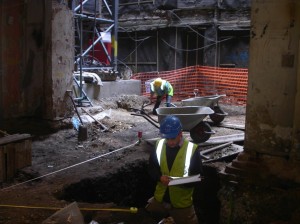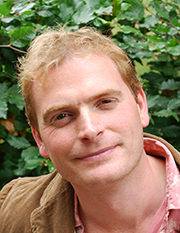 I became a professional fieldworker in 1998 – the year I graduated from university. I had done fieldwork before that, but this was the first time I was actually paid to do it. I joined what was at the time a small company in London that specialised in digging archaeology in advance of building developments. These were the boom years; the housing market exploded and the company I worked for grew in size, becoming one of the largest in the country. I was hardly ever out of the field. Initially the plan was to get a few weeks digging experience before starting a masters degree, but commercial digging seemed so much more relevant to me than abstract, blue skies academia (plus it was a lot of fun) and so I stayed. In fact I stayed for seven and a half years. I dug sites of every period, mostly in London, and they were good sites – deeply stratified with tonnes of finds – the very best in Britain. We dug Roman and medieval sites in the City of London, and sites in Convent Garden, which was once the beating heart of Saxon Lundenwic. We dug prehistoric sites in Southwark and post-medieval industrial sites along the foreshore. Everything and anything – it was pretty much the best training ground I could have asked for.
I became a professional fieldworker in 1998 – the year I graduated from university. I had done fieldwork before that, but this was the first time I was actually paid to do it. I joined what was at the time a small company in London that specialised in digging archaeology in advance of building developments. These were the boom years; the housing market exploded and the company I worked for grew in size, becoming one of the largest in the country. I was hardly ever out of the field. Initially the plan was to get a few weeks digging experience before starting a masters degree, but commercial digging seemed so much more relevant to me than abstract, blue skies academia (plus it was a lot of fun) and so I stayed. In fact I stayed for seven and a half years. I dug sites of every period, mostly in London, and they were good sites – deeply stratified with tonnes of finds – the very best in Britain. We dug Roman and medieval sites in the City of London, and sites in Convent Garden, which was once the beating heart of Saxon Lundenwic. We dug prehistoric sites in Southwark and post-medieval industrial sites along the foreshore. Everything and anything – it was pretty much the best training ground I could have asked for.
It was hard work, of course, and working on building sites wasn’t always easy. These were unashamedly masculine spaces, and I know it was easier for me as a man than it was for my female colleagues. Certainly when I worked in that environment (perhaps things have changed now) most construction workers were men and talk had more than a hint of testosterone to it. That is not to say that everyone lived up to their wolf-whistling stereotypes, but it wasn’t uncommon to find a rolled up porno in the Portaloo. In fact, women on site were largely restricted to archaeologists and although it may not have been common, they did at times find themselves subjected to inappropriate comments. When this happened, though, our team were always quick to pull them up on it, and on one site I was supervising in the City we all walked out after a scaffolding team offended a female archaeologist working below. The whole site shut down until we agreed to return after an apology.
Occasions like that were rare though, and I thoroughly enjoyed my time in commercial archaeology – as did, I think, most others working there then – male or female. In fact, we had the times of our lives; working, drinking, laughing, the banter – I miss it, and nowhere else I’ve worked has quite captured that dynamism, excitement, bonhomie and joie de vivre. It was there, too, that I met my wife – a fellow archaeologist enjoying and dealing with the daily trials of working on building sites in London – a relationship forged in the white heat of commercial digging.
You can’t dig like that forever though, and we eventually moved on. I joined the Research Department at English Heritage, remaining there also for seven and a half years. I directed some fantastic excavations with EH – from the great prehistoric mound of Silbury Hill to Marden henge – the largest Neolithic henge in the country. And now I am the Director of the Archaeology Field School at the University of Reading. We will be going back to dig at Marden henge next year with the Field School and I’m really looking forward to it. I can’t imagine life without fieldwork – it is, as American archaeologist Kent Flannery once put it, “the most fun you can have with your pants on”.
Dr Jim Leary is Director of the Archaeology Field School in SAGES. Jim Leary convenes the Archaeological Thought and Careers in Archaeology modules, and contributes to the Practicing Archaeology module. In 2007 and 2008, he directed the major excavations into Silbury Hill and has managed the post-excavation programme since. He co-authored the monograph of this work, as well as a popular account (with a foreword by David Attenborough). In 2010 Jim directed excavations at Marden henge, which lies between Stonehenge and Avebury, revealing one of the best preserved Neolithic buildings in England. More recently Jim assisted with work that cored through the Marlborough Castle Mound, conclusively proving for the first time that its origins are prehistoric and contemporary with Silbury Hill. Jim has also researched perceptions and understandings of sea-level rise in the Mesolithic, as well as mobility and movement in archaeology. He sits on the council of the Prehistoric Society, and has written a chapter on excavation and evaluation for the Avebury and Stonehenge WHS Research Agenda. Jim has also written numerous archaeology-related articles for popular magazines and journals.



